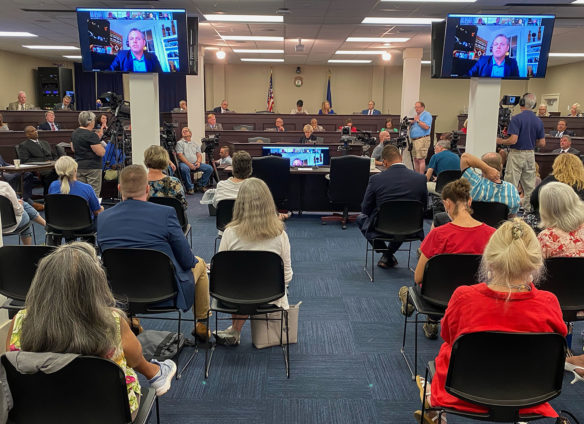
Education Commissioner Jason E. Glass virtually presents before the Interim Joint Committee on Education. Jefferson County Public Schools Superintendent Marty Pollio and Kelland Garland, principal of Hebron Middle School (Bullitt County) joined Glass to provide K-12 perspectives on critical race theory.
Photo by Toni Konz Tatman, July 6, 2021
- Joining Education Commissioner Jason E. Glass in providing K-12 perspectives on critical race theory to the committee were Jefferson County Public Schools Superintendent Marty Pollio and Kelland Garland, principal of Hebron Middle School (Bullitt County).
- Equity in education and critical race theory are not the same thing, Glass said.
By Jacob Perkins
Jacob.perkins@education.ky.gov
As the national conversation surrounding critical race theory continues to escalate, Kentucky Commissioner of Education Jason E. Glass urged the Interim Joint Committee on Education to remain committed to providing an equitable education to all students.
According to Glass, critical race theory is a longstanding legal and academic theory that seeks to explain why racism continues to exist. The theory – primarily used in universities – is meant to provide a framework for the study of potential causes and effects of racism in society and how they might be mitigated.
In terms of whether critical race theory is being taught in Kentucky’s K-12 schools, Glass said the state leaves decisions about what type of curriculum and resources will be used in a classroom to school-based decision making councils.
The Kentucky Department of Education (KDE) only has the authority to set the Kentucky Academic Standards – which detail what a student should know and be able to do at each grade level – in consultation with teachers. At this time, KDE is not aware of any districts or teachers specifically teaching the theory, nor does it appear in the Kentucky Academic Standards.
Joining Glass in providing K-12 perspectives on critical race theory to the committee were Jefferson County Public Schools Superintendent Marty Pollio and Kelland Garland, principal of Hebron Middle School (Bullitt County).
Creating an inclusive curriculum and working toward equity does not mean lifting any one group of people while putting down another, Pollio said. It is about providing appropriate support to every student.
“We have to give our students the world and let them determine their path,” he said. “… With the support of KDE and the Kentucky Board of Education, I believe we have the opportunity to be a true leader of this work in Jefferson County and the Commonwealth of Kentucky.”
Committee members asked if there should be transparency in the development of curriculum, something that Garland says already exists.
All the state’s academic standards are available online, and all school-based decision making council meetings are open to the public.
KDE’s Equity Work
As Glass began discussing the department’s work around equity, he clarified that equity in education and critical race theory are not the same thing.
“Equity in education is fundamentally an effort to ensure that all of our students have the supports they need to meet our academic standards and to reach their full potential as students, citizens and human beings,” Glass said. “An equity focus in education recognizes that public school students come to us with a variety of backgrounds, needs, supports and experiences and that we must take those into account when we consider the education of each child.
“When we provide students with disabilities the supports they need to participate in school and access the curriculum, this is equity. When we make sure our children are not hungry at school by providing them with free or reduced-price meals, this is equity. When we make sure that our students who are learning English are provided the supports they need to learn it and to continue learning in their other subjects, this is equity. When we make sure our poorest and most rural parts of the state have access to a high quality and representative teacher workforce, this is equity. When we make sure that students who have different levels of support at home can participate in events, trips, sports and extracurricular activities regardless of their backgrounds, this is equity. And when we make sure that none of our students are taught under the ‘soft bigotry of low expectations,’ as President George W. Bush once said, this is equity.”
The department’s equity work includes the development of an optional “equity toolkit” for schools and districts. The Toolkit will include:
- An equity dashboard, where differences in outcomes across several different student subgroups; and
- An equity playbook, which includes five strategic moves a school or district can enact to improve equity, such as making sure that all students have access to high-quality instructional resources, evidence-based instructional practices and high-quality teachers.
In addition, KDE hopes to increase and retain greater numbers of minority educators as part of a larger educator pipeline effort called GoTeachKY.
“We are also developing optional training modules for Kentucky educators related to their expectations for students, and how we must hold all of them to high standards with the belief that every child is capable of success,” Glass said.
Being a student who struggled in school, Rep. Killian Timoney (Fayette County) appreciates the department’s efforts toward providing a more equitable education system for all students.
“I did have some teachers that were able to provide services to me outside of the regular school day to ensure that I got to the finish line approximately the same time as the rest of my classmates,” he recalled. “… I learned very early on that equity in school is very important to make sure all of our students reach the finish line.”
With committee members trying to differentiate between equity and equality, Timoney – a former Fayette County educator – said he uses real-world examples to help people understand concepts, including equity.
To understand the difference between equity and equality, he used an example of an emergency room physician treating every patient with a Band-Aid, regardless of the injury.
“That’s equality,” he said. “Equity would be determining what you needed and providing it for you in order to make it to the finish line, which would be regaining full health.”
To provide the committee with another model, Timoney focused on crime in his local community.
“Sadly, there are disproportionate amounts of crime in parts of Lexington,” he said. “If we used equality, we would have the same amount of police support throughout the city. That’s not how it works. Providing the resources for what people need and what communities need, sometimes you have to venture into equity and provide the resources necessary. …
“In some facet of our lives, equity has played a part and we wouldn’t be where we are without it.”
Pre-filed Legislation
Two pieces of proposed legislation, Bill Request (BR) 60 and BR 69, are particularly concerning to Glass, as they seek to define what can and cannot be taught or discussed, either formally or informally, in Kentucky’s public schools related to a number of concepts, including race and other controversial matters.
Rather than simply banning critical race theory in Kentucky’s public schools, Glass recommended the General Assembly consider enacting legislation that forces these conversations to have balanced perspectives and “does not censor classroom discussions and does not threaten public educators.”
By doing this, Glass said Kentucky’s legislators would embrace the American values of tolerance of different points of view and perspectives, values around free speech and the importance of the free exchange of ideas.
“This approach still allows local school-based councils to make curricular decisions for their schools,” he said. “If a school-based council decides to have some class that covers critical race theory, then they would also have to provide balanced perspectives on the topic. This approach also does not put this legislative body in the business of banning or censoring ideas or free speech, nor limiting the free exchange of ideas in the classroom.”
The current pre-filed bills related to critical race theory are patterned after legislation in other states, Glass said.
“I urge Kentucky’s legislators not to simply follow in those authoritarian footsteps and adopt this troubling legislation, but instead to adopt a better approach – one which is in keeping with our values as Kentuckians and Americans, and does not debase them,” he said.
After a discussion on BR 69, many committee members described the bill as “vague” and advised the sponsors to work to provide a clearer piece of legislation.




Leave A Comment